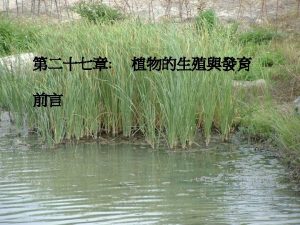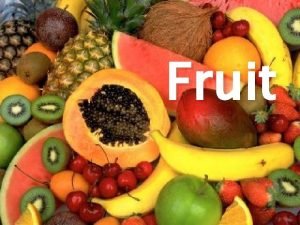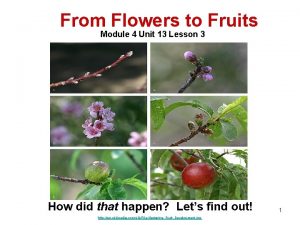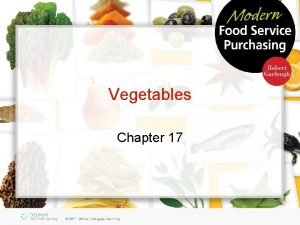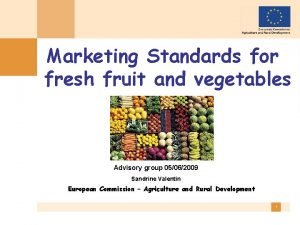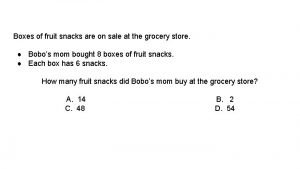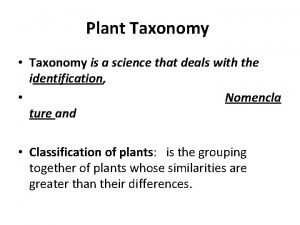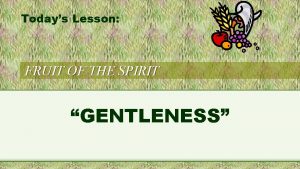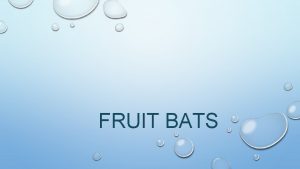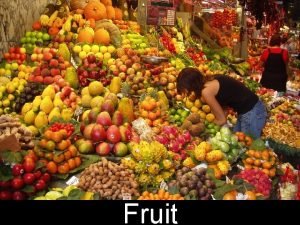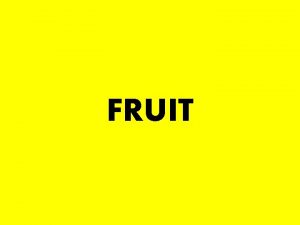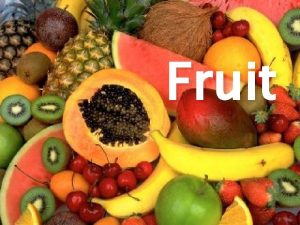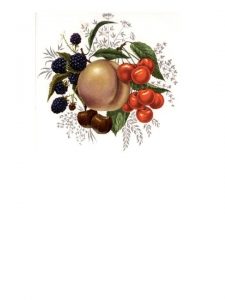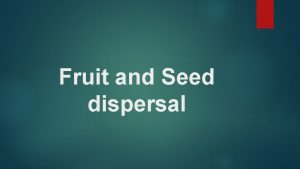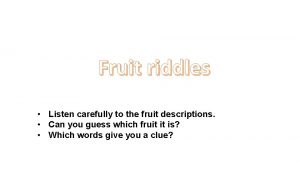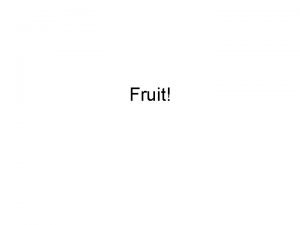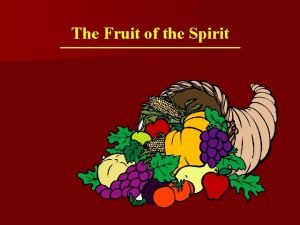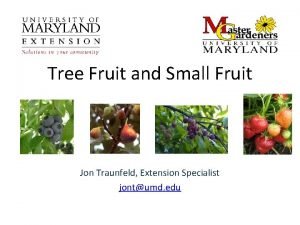Fruit Culture Fruit Culture Fruit Culture is a
































- Slides: 32

Fruit Culture

Fruit Culture • Fruit Culture is a branch of horticulture that deals with the production, storage processing and marketing of fruits.

Fruit • Botanically A fruit is developed ovary of a flower after fertilization has taken place • Horticultural Sense Fruit is something which is eaten fresh and out of hand



Categorization of Fruits • 1. Temperate Fruits • 2. Sub Tropical Fruits • 3. Tropical Fruits

Temperate Fruits • Pome Fruits (Apples, Pears) • Stone Fruits (Cherry, Apricot, Peach, Plums) • Small Berry Fruits (Raspberry, Strawberry, Grapes)




Sub Tropical Fruits • Avocado • Citrus


Tropical Fruits Tropical countries are enriched with large number of fruits (Few Examples) • Mango Durian • Banana Rambutan • Papaya Anonas • Mangosteen Pineapple • Cashew Pomegranate

Categorization of Tropical Fruits 1. Well Known 2. Less Well Known 3. Exotic

Well Known Fruits • Fruits which are cultivated commercially and received sufficient Scientific attention e. g. Mango Citrus Pineapple Avacado Papaya Guava Banana

Less Well Known Fruits (Under Utilized) • • Fruits that are rarely found in the Market They have fairly narrow growing season Not Cultivated Commercially In adequate Scientific investigations





Exotic Fruits • Fruits that are introduced from other countries • Rambutan • Durian • Mangosteen




Importance of Fruits 1. Source of Nutrients (per 100 g of fruit) Fruit Cal Proteins Ca Fe (g) (mg) Thia min (mg) 0. 05 Vit C (mg) 0. 5 Vit A IU 100 Banana 116 1. 0 7. 0 Mango Pineapple Papaya Cashew nut Avocado Rice 63 57 39 590 0. 5 0. 4 0. 6 20 10. 0 20 50 0. 5 5 600 1000 - 0. 03 0. 08 0. 03 0. 06 30 30 50 - 165 340 1. 5 10 1 200 0. 07 15 10

2. As a Foreign Exchange Fruit Volume (MT) Rs (Million) Pineapple 715 26. 45 Banana 425 5. 0 Mango 15 1. 65 Avocado 0. 5 0. 02 Guava 0. 5 0. 01

3. Supply of valuable by products Papain –Papaya Oil - Cashew, Citrus 4. Use as ornamental trees 5. Use in Agro-forestry Systems

• • • 6. Environmental Importance e. g. Water Use efficiency Soil Conservation High Carbon Dioxide Fixation Support the Wild Life • 7. Socio-economic Importance

Fruit Cultivation in Sri Lanka Total Area Under Cultivation -70, 000 ha Annual Production - 560, 000 t

Annual Cultivation and Production of Major Fruits in Sri Lanka Fruit Banana Extent of Cultivation Annual Production (t) (ha) 56589 405726 Mango Lime Pineapple Orange Papaw Guava Passion fruit 16107 6652 4046 3840 2677 2537 441 67588 62426 43855 13575 13933 9989 764

Constraints • • Land Scarcity Initial Lag Period of Low Farm Returns Difficulties in gaining foreign market Heavy Post Harvest Loses Un-availability of good planting materials Poor market facilities Poor Management

Solutions • • • Financial Support- (Subsidy schemes, loans) New Cropping Systems Introduction of New Varieties Farmer training programs Rapid Multiplication techniques Improve Fruit Processing Industry
 Statolith in plants
Statolith in plants Partes de una planta
Partes de una planta Fruit and vegetable meaning
Fruit and vegetable meaning Fruit parts
Fruit parts Stab and stroke culture
Stab and stroke culture Folk culture and popular culture venn diagram
Folk culture and popular culture venn diagram Site:slidetodoc.com
Site:slidetodoc.com Fed-batch
Fed-batch Quality culture vs traditional culture
Quality culture vs traditional culture Folk culture and popular culture venn diagram
Folk culture and popular culture venn diagram Non material culture examples
Non material culture examples Inert organizational culture
Inert organizational culture Characteristics of collectivism
Characteristics of collectivism Surface culture deep culture and esol
Surface culture deep culture and esol What is a subculture
What is a subculture Individual culture traits combine to form culture patterns.
Individual culture traits combine to form culture patterns. Anaerobic gaspak
Anaerobic gaspak Indian culture vs american culture
Indian culture vs american culture Popular culture examples
Popular culture examples Batch culture vs continuous culture
Batch culture vs continuous culture Lawn or carpet culture method
Lawn or carpet culture method Romaine lettuce growing stages pictures
Romaine lettuce growing stages pictures Marketing standards for fresh fruit and vegetables
Marketing standards for fresh fruit and vegetables Extended metaphor
Extended metaphor 7 blessings of tithing
7 blessings of tithing Of man's first disobedience and the fruit explanation
Of man's first disobedience and the fruit explanation Boxes of fruit snacks are on sale at the grocery
Boxes of fruit snacks are on sale at the grocery Language
Language Loculicidal capsule fruit
Loculicidal capsule fruit Fruit of the spirit gentleness lesson
Fruit of the spirit gentleness lesson Dominant vs recessive genetic disorders
Dominant vs recessive genetic disorders Amazon
Amazon United fruit company poem
United fruit company poem
